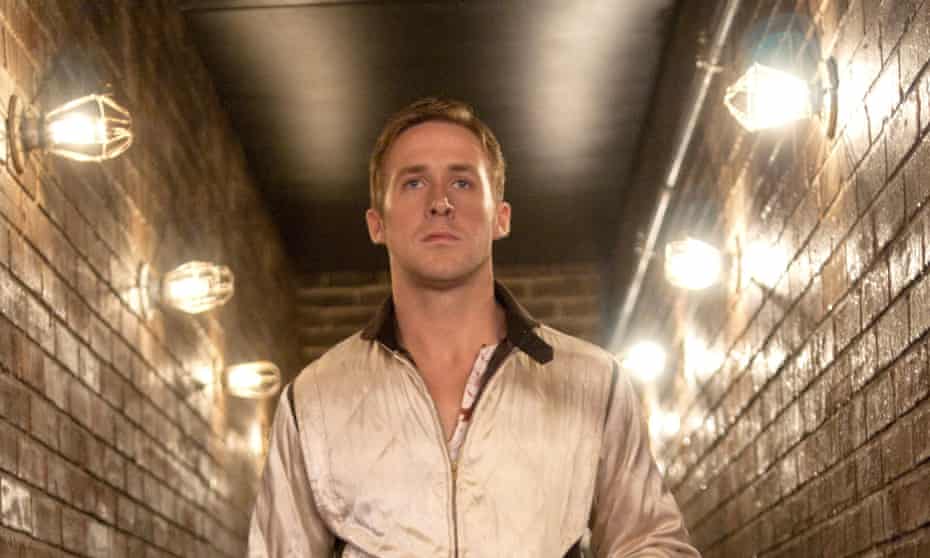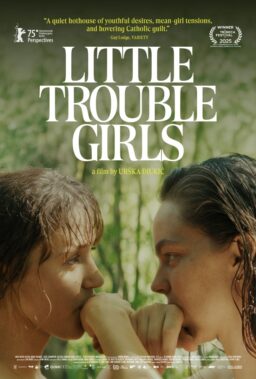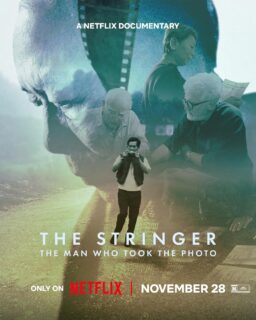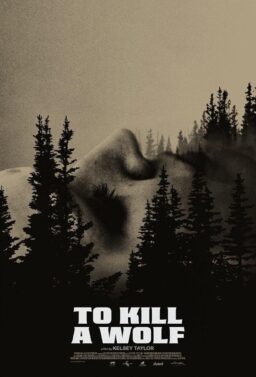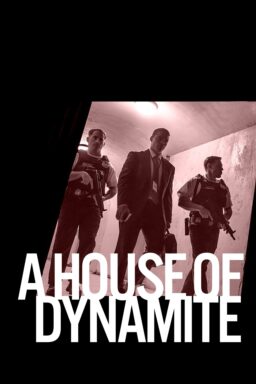Nicolas Winding Refn’s “Drive” is the intersection of existential samurai films and heightened crime epics, a juxtaposition of sensorial bliss with patient ritualism. Taking inspiration from the minimalist crime films of Jean-Pierre Melville—which were themselves informed by the wandering, warrior-code archetype of Japanese cinema’s Jidaigeki pictures—”Drive” paints a city of angels and demons inhabited by shifty used car salesmen and strip mall pizzeria owners. Or put it another way, it’s a Michael Mann film by way of Seijun Suzuki.
Arriving on the site of his day job—an average repair garage on Reseda Blvd.—in the middle of the night, Ryan Gosling’s nameless driver stands in the reflection of a muscle car window, putting his gloves on. His boss/handler, Shannon (Bryan Cranston) pushes his body off the hood, limping to sell him on tonight’s getaway vehicle. “Plain Jane Boring, just like you asked for, but I dropped another 300 horses on the inside; she is gonna fly!”
What follows is a pulse pounding LA street heist. Set to The Chromatics’ “Tick of the Clock,” the opening stretch of “Drive,” which turned 10 this month, throws the audience into a ritual of intimate process, packaging itself with firmly established genre wrappings. Posturing beside a lonesome lamp in his Echo Park apartment, the Driver knows precisely where tonight’s story is going to go—in fact it’s built into his plan, which involves coinciding the job with the Clippers game letting out of Staples Center. Cut to a windshield shot. Road sounds hum, the music track thumping like a heartbeat.
Refn’s movie presents peak stylistic postmodernism maximizing its genre reverence, and minimizing all extraneous plot. Effectively a polished re-telling of a tale told before (via Walter Hill’s “The Driver,” Michael Mann’s “Thief,” and Jim Jarmusch’s “Ghost Dog,” and others) “Drive” can almost be over-simplistically described as a cover of Melville’s “Le Samourai,” but the 2011 film is evidence that cinematic reverence has evolved into a subgenre itself.

“Drive” is a mixtape of silent ronin posturing and repressed male longing; it’s cinema’s far-reaching myth of the self-imposed, honorable warrior-type repackaged. Refn’s film plays like a dream pop adrenaline shot—uber style oozing sensitivity beneath the surface. The opening scene acts as a compressed version of the prologue of “Le Samourai,” in which its titular figure, Jef (Alain Delon), carries out a cocktail club hit in disciplinary fashion, donning a fedora and trench coat. Upon exiting, the piano player (Cathy Rosier) sees our samurai, resulting in a violation of his moral code. Normally, he’d leave no witnesses, but an unspoken camaraderie between him and this woman overtakes emotion.
In contrast to the one-note grit one might assume another modern retooling to take, an affection for fairy tale romanticism shines through Refn’s aesthetic, rendering it a much more personal retelling as he doubles down on highlighting the fable-esque components of a tough guy who goes soft behind the eyes.
“Do you know the story of The Scorpion and the Frog?,” Gosling’s nameless silhouette asks his underworld adversary, Bernie Rose (Albert Brooks)—the actor having also priorly discussed his wheelman character representing a knight in a fantasy legend, with Irene (Carey Mulligan) being the damsel in distress. But the damsel is already married to Standard Gabriel (Oscar Isaac), a man about to get out of prison who owes money to the wrong sorts, looking for penance just like our nameless hero.
The origin story recounted by Standard fits Refn’s artistic intention like a glove: “Where’s the Deluxe version?” Irene asks her so-called savior. As this romantic tale is retold we see how it is all our Driver longs for. For many reasons—most of which involve self-hatred—our hero can never utter his emotions aloud, yet they can often be seen all over his face, feelings of needed infatuation, of some kind swelling behind sad eyes, the key to where Gosling’s performance differs from Delon’s. Driver’s growing feelings for Irene and her son Benicio (Kaden Leos) are the spark that allows a self-loathing vessel to feel like a “real human being” again, echoing Jef’s care/concern for the pianist. For the first time in a long time, an empathetic gaze reminds these disciplinary archetypes that they don’t always need to feel like the bad guy. Breaking his own underworld rules of personal investment leads our hero to take a job that gets his damsel’s knight in shining armor killed.
But if Meville’s seppuku-inspired code-breaking is the blueprint/battle plan for our ancient hero myth, then director Seijun Suzuki—known for making B-movie Yakuza films for Japan’s Nikkatsu studios—would be the aegis in scorpion jacket form. The story and structure of the conveyor belt-type flicks Suzuki helmed were most always the same: the main character (usually a criminal, or ex-cop with a code of honor) meets a girl, defends her from the bad guy, and wins her affection in the end, echoing damsel in distress narratives.

Stripping down mythic symbols and archetypes to the artistically abstract—much like Melville does, though in a far more buoyant manner—Suzuki’s “Tokyo Drifter” repeatedly repackages established genre situations such as the train track stare down from classic cowboy pictures. The protagonist is named Tetsu the Phoenix (Tetsuya Watari) and his villainous rival, Tatsuzo The Viper (Tamio Kawaji). Driver the Scorpion doesn’t have the same chill air of cool to it.
Lifting numerous other expressive elements such as Suzuki’s striking use of color, “Drive”’s fairy tale gangster atmosphere is certainly indebted to “Tokyo Drifter,” as well as other stylish crime/hitman films released during the same period. But it’s the monologue from Michael Mann’s diner scene in “Thief,” that nails the tragic theme of Refn’s fable.
“You gotta not give a f**k if you live or die,” professional safecracker Frank (James Caan) tells a woman he’s developed feelings for. “You gotta get to where nothin’ means nothin’. I’ll tell you a story all about it…” He proceeds to tell his own damsel about getting beat-half to death when he was in the can, expressing the reason for his survival was all in posturing and presentation. “I don’t care about me. I don’t care about nothin’. And I know, from that day, that I survived because I achieved that mental attitude.”

Gosling’s wheelman can certainly relate. A stuntman by day and a street samurai by night, Driver’s lonely existence consists of being a faceless work horse thrown around like a ragdoll, who chauffeurs low-level criminals in his off time. In the only professional interaction we see on set, he’s signing a waiver in case he dies or gets maimed. His self-imposed lifestyle no doubt has a story behind it but that isn’t the tale Refn is telling.
“Drive” is perhaps the director’s most universally beloved film due to how much it wears its emotional authenticity on its sleeve. It’s a story about failing someone you fall in love with and retreating into the jungle after doing so. The reason these samurai live by a code is because the world has deeply pained them; they feel repentant and responsible, unwavering in their unselfishness, swearing off all desire in favor of self-instruction. What makes Refn’s film so special is how this honest vulnerability is played with the same, straight stone-cold face as its revved-up genre aesthetic—the discipline is the directness, and it’s a concession of how myths can lead to masochism.
When the lights flicker for “Drive”’s famous elevator kiss—our hero’s sole romantic confession—that’s when his stinger comes out. A fantasy passes. A damsel is attacked. Our knight bashes a guy’s brain in. Care comes to be overshadowed by fear, and we understand why this man wears the symbol of a scorpion on his back. Feeling like too much of a monster to ever deserve somebody special in his life, regimental discipline has won out, turning the sharp end back on himself. The myth of what Driver represents has come to define him, and so too does the artistic atmosphere of Refn’s samurai movie. “Drive” is a film about existing in a perpetual state of so-called cinematic harakiri—a heightened, archetypical hybrid of samurai and yakuza films distilled to the form a lonely, broken heart.
